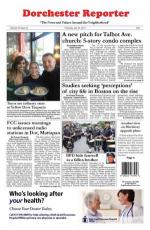November 14, 2012
In the January 2010 special election between Scott Brown and Martha Coakley, I handed out poll cards for Coakley outside the Kenny School in Ward 16, Precinct 9 in the Pope’s Hill section of Dorchester. I was pessimistic about her chances at that point; the polls showed Brown surging, and as voters went by me, they were not indicating great support for my candidate. In this white working class precinct, Brown won, 491 votes to 321 votes, or 60 percent to 40 percent.
About a mile away, the Ward 15, Precinct 3 vote was held at the firehouse beside the big white wooden church on Meetinghouse Hill. That precinct, made up mostly of African Americans, Latinos, and Cape Verdeans, favored Coakley by 179-23, or 87 percent, but it was not a great turnout.
In last week’s election, Sen. Brown again won Ward 16, Precinct 9, but this time the margin was much closer: Brown beat Elizabeth Warren, 595 votes to 499 votes, or 52 percent to 48 percent. Meanwhile, in Ward 15, Precinct 3, turnout almost doubled from 2010 and Warren beat Scott Brown, 357-32, getting 92 percent of the vote. The precinct went for Obama by 95 percent, or 371-18.
We know that Mayor Thomas Menino’s organization, labor unions, and some community groups worked very hard in this election to do two things. One was to highlight by extensive door knocking, phone calls, and mailings the fact that Sen. Brown, despite his average Joe image, had voted against average people on issues like taxes and the rich, extending unemployment benefits, and supporting equal pay for women. The other was a massive turnout effort on Election Day that targeted every registered voter in neighborhoods that were predominantly people of color and in white working class and mixed neighborhoods, targeting those identified as supporting Warren.
A candidate has to run a good campaign to win and Warren did. Yet, this process of identifying and turning out your vote can be worth up 3-5 percentage points in a candidate’s favor, which was close to her margin of victory.
The turnout was astounding. After working for a state senate candidate outside of Dorchester, I went to vote at the Lower Mills Library at 11 a.m., usually a slow time with no wait. It seemed that would be the as I approached the library and no one was outside handing out cards. But what a surprise when I went inside: a line of 40 people waiting to cast their ballots.
Later, at 5 p.m., I was handing out poll cards for Warren at the Codman Square Tech Center at the corner of Washington and Park streets where I was greeted by a line of 50 people outside, a line that never got smaller over the next 2 1/2 hours. To encourage voters to stay in line and to be nice, the mayor’s organization and the Warren campaign had dispatched a station wagon with meatball subs and broccoli and chicken while another person kept patrolling the waiting line with hot chocolate. Meanwhile, the energetic Doreen Tracey devised a way for more people to be able to stand inside out of the cold while periodically shouting out cheers for “seventeen three.”
That’s Ward 17, Precinct 3. I imagine most people on line hearing that did not know what she was talking about but people got the meaning with her enthusiasm. We later read that this was the highest Boston voter turnout since 1964.
Through the night, we saw President Obama defeat Mitt Romney. I remember that when Romney ran against Senator Kennedy in 1994, there was a reference to a part of Dorchester with some deteriorated and abandoned buildings that caused Romney to say disparagingly, “that was Kennedy country.”
Dorchester has many fewer abandoned houses now as the housing market has recovered from then, although the foreclosure crisis and the drop in home prices have hurt us again, but Romney and Brown did find out last week that Dorchester is still Kennedy country.
Lew Finfer is a Dorchester resident


